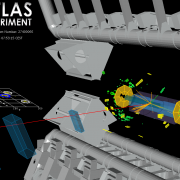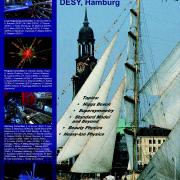Access to Collaboration Site and Physics Results

Ordinary matter is made of just three kinds of elementary particles: up and down quarks, which form the atomic nucleus, and electrons, which surround the nucleus. But the rest of nature is not so straightforward: heavier forms of quarks and leptons are produced regularly at particle accelerators. The top quark is the heaviest of the known fundamental particles. Since its discovery in 1995 at the Tevatron proton–antiproton collider at Fermilab, USA, the study of top quark properties has been a key part of high-energy physics research.
The top quark’s very large mass – as heavy as a gold atom and 180 times heavier than a proton – remains a mystery. It might be related to as-yet undetected phenomena beyond the Standard Model, and thus the top quark plays an important role in searches for new physics.
According to the Standard Model, the top quark immediately and almost always decays to a b-quark and a W boson. However, some new physics models predict that decays to either an up or charm quark together with a Z boson (t → uZ or t → cZ) can also occur. An observation of these processes would therefore be a smoking gun for physics beyond the Standard Model.
Physicists from the ATLAS Collaboration analysed 13 TeV proton-proton collision data collected by the detector to search for such decays in top-antitop quark pair events. ATLAS selected events where one of the top quarks decayed normally to a b-quark and a W boson, while the other decayed to an up or charm quark and a Z boson. No excess of events with this signature were found above the background expectation and thus 95% confidence level upper limits were derived on the branching fractions of the top quark to an up or charm quark and a Z boson of 0.017% and 0.023%, respectively. These are the most stringent limits on such processes to date.
Although a null result may seem disappointing, it still provides important information. Theorists propose new physics models that go beyond our present knowledge, and experimentalists test these proposals with data. Sometimes evidence appears, eventually culminating in a discovery. But more often, the data show no evidence for the proposed new physics phenomenon. In such cases, the results allow us to constrain, and eventually exclude, theoretical models.
The ATLAS result significantly improves the limits on the t → uZ and t → cZ decays. If new physics exists that results in such a decay, it must be a very small effect, and any model that predicts a large rate is ruled out.
Links:
- Search for flavour-changing neutral current t to qZ top quark decays in proton-proton collisions at s√s = 13 TeV with the ATLAS detector (ATLAS-CONF-2017-070, figures).
- See also the full lists of ATLAS Conference Notes and ATLAS Physics Papers.








